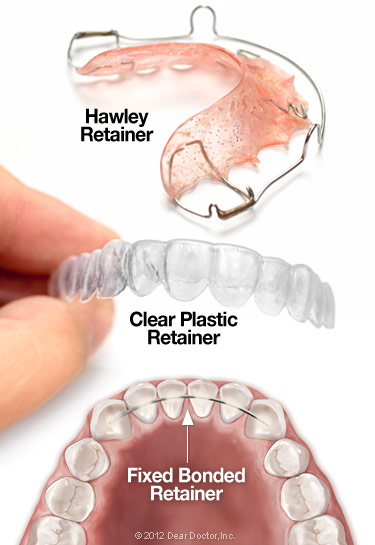Retainers
It’s exciting to have your braces removed, but don’t run away with your perfectly straight teeth just yet. You will be given a retainer after your active orthodontic treatment period has ended and your braces have been removed.
The purpose of a retainer is to keep teeth in their new positions while the jawbone, gums, and muscles adjust. It’s critical to understand that teeth can move without retainers.
Why do teeth shift after braces are removed?
Your braces keep your teeth in place during orthodontic treatment. When braces are removed, the gums’ stretched elastic fibers try to pull the teeth back to their original position, which is known as “orthodontic relapse.” These fibers take time to stop pulling on the teeth.
Following the completion of treatment, continued jaw growth may cause teeth to shift. It’s critical to follow your orthodontist’s instructions and wear your retainers as directed, or your teeth may revert to their previous positions.
You’re most at risk of relapse right after your braces are removed, but your teeth will gradually stabilize over time. This does not imply that you can take your retainer out after a few months. Retainers are a long-term commitment that ensures your teeth stay in place.
They’re both stylish and practical.
Removable Retainers
They look like a thin, clear gumshield that fits over your teeth to keep them from moving.
Your removable retainers will be made specifically for you. We’ll take impressions of your teeth after removing your braces. We fit your retainers on the same day we remove your braces to minimize any teeth movement.
Your orthodontist or orthodontic therapist will tell you how frequently you should wear your removable retainers; in most cases, you’ll only need to wear them at night. When you’re not wearing them, keep them safe because they have a tendency to vanish.
Fixed Retainers (Bonded Retainers)
Fixed retainers are also available for our patients’ added peace of mind. A thin stainless steel wire is permanently bonded behind the front teeth to create these. Before taking impressions for your removable retainers, we usually fit your fixed retainers as soon as your braces are removed.
Fixed retainers are virtually undetectable and are quickly forgotten. Just remember to pay extra attention to them when brushing your teeth. We’ll show you how to clean your retainers properly.
When Should Your Retainer Be Worn?
Wear your retainer according to your orthodontist’s instructions. In the first 10 days after getting their braces off, most patients must wear their retainer for the majority of the day (even while sleeping). Most patients can wear their retainers only at night after that time period. When eating, swimming, or participating in strenuous sports, the retainer should be removed.
Pain And Soreness
Your teeth may become sore from the retainer, and your speech may be slightly altered for a few days. This is common when getting a new retainer or after an adjustment, and it will go away on its own. Call our office if you develop a sore spot on your gums so we can adjust your retainer for better comfort.
Cleaning Your Retainer
Brush your retainer with soap and room temperature water on a daily basis. For a more thorough cleaning, use a retainer cleaner (such as Retainer Brite or a denture cleaning tablet). If you have a bonded wire retainer behind your front teeth, brushing your teeth should include cleaning it as well. To sterilize your retainer, do not boil it.
How To Keep Your Retainer Safe
The retainer should be removed during meals and for cleaning because it is removable. However, you must be cautious not to lose your retainer. Keep it in its case when eating meals to keep it safe. Never put your retainer in your pocket or wrap it in a napkin. Keep it away from dogs and cats, who enjoy chewing on these items. Please note that lost or broken retainers will incur an additional fee.
Retainers Treatment Time
Treatment time for retainers varies depending on the patient. Permanent retention may be required in some cases to keep teeth aligned properly. We’ll talk about it as part of your overall treatment strategy.
Remember that your retainer will only work if you wear it! If you have any questions about retainer use, please give us a call.


